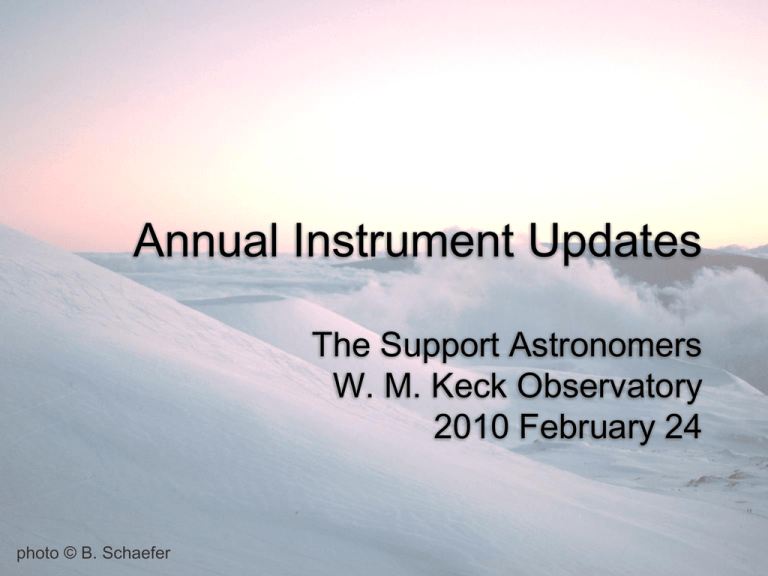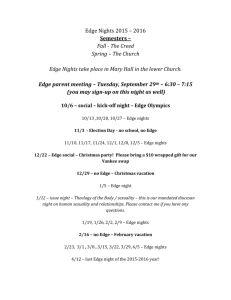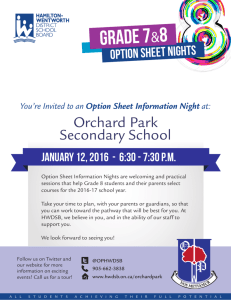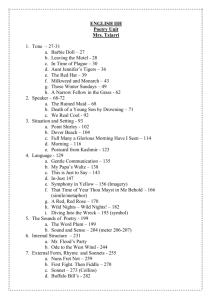2010 SSC instrument reports v6
advertisement

Annual Instrument Updates The Support Astronomers W. M. Keck Observatory 2010 February 24 photo © B. Schaefer ESI Greg Wirth ESI Current Status Good news ESI working well overall Mechanical stages AOK MAGIQ software now on ESI Bad news Motor controller software can no longer be compiled from source ESI Usage Semester Nights 2008A 16 2008B 5 2009A 4 2009B 3 (+1 eng) 2010A 7 3 ESI Integral Field Unit (IFU) ESIESI Echellette Spectrum IFU Spectrum 4.0” Delivered and tested in 1994 5.7” target acquisition problematic Commissioning completed 2010-Jan-17 target acquisition solved Now released for use Documentation underway 4 DEIMOS Greg Wirth DEIMOS Current Status DEIMOS continues to perform well overall; no major problems Signal dropouts on CCD1 became a problem Traced faults to bad cable; now fixed Concerns: Grating tilt stages show occasional unrepeatability; possible mechanical problem with encoder mount Slitmask system generates metal “dust” in focal plane requiring regular cleanup; no easy fix 6 DEIMOS Mask in Focal Plane 7 DEIMOS Slitmask Debris 8 DEIMOS Future Priorities Replace rotator control host Concern about obsolescence of Linux box Upgrade instrument control host New hardware Rebuild software for greater maintainability Revamp DEIMOS web pages 9 DEIMOS/LRIS Slitmask Milling 10 Slitmask Mill Spindle Table 11 DEIMOS/LRIS Slitmask Milling Slit quality remains uneven Summit staff are improving operation: Using new tool for more accurate depth calibration Doubling tabletop thickness for better stability and flatness Increasing vacuum for better suction Implementing regular mill PM program 12 NIRSPEC Jim Lyke NIRSPEC Extended AO capability Replaced Br- filter with AO pupil stop Access to KL, M-wide filters behind AO SCAM reading all 4 quadrants Since September 2009 service Server Crashes One crash every four nights 20 min average per crash 14 NIRSPEC Service UCLA fabricated pupil I. McLean, G. Brims, J. Canfield, T. Aliado Access port allowed in situ swap Smooth service Servicing team G. Hill, M. Wagner, A. Agliam, J. Lyke (I. McLean by phone) 15 NIRSPEC AO AO pupils are aligned Easily switch between the two filter wheels Software New scripts EFS updated (no change for observers) XNIRSPEC needs updating Test data look good Mars methane measurements coming in early April. 16 NIRSPEC SCAM Wires found pressed against radiation shield Consultation with PI, Ian McLean Carefully relocated wires Four good quadrants since September Dewar tape SCAM wires 17 NIRSPEC Server Crashes Causes Fiber degradation OTDR inspection shows marginal performance Cleaning generally helps Connectors sensitive to alignment XNIRSPEC blocks server Server unresponsive Exiting XNIRSPEC “cures” crash 18 NIRSPEC Server Crashes Mitigation Fiber degradation Optimizing fiber assignment More frequent cleaning Improve tech training XNIRSPEC blocks server Update “recover” script 19 OSIRIS Jim Lyke OSIRIS Fourth service successful Temperatures nominal Detector temps stable Good image quality Previous three services Replaced cold head Fixed image motion with scale change Calibration updates Wavelength calibration as function of temperature Rectification matrix improvements 21 OSIRIS Temps Current Last Year 22 OSIRIS Near Future Move to K1 planned for late 2010B DRP v2.3 coming Fewer RecMat spikes Wavelength solution as function of T New AO dichroic Lots of work by Shelley Wright and James Larkin 23 OSIRIS Upgrades? Grating ~30% efficient Possible to double this in J-band Detector/Electronics Read-noise Dark current OSIRIS 10 e– 0.056 e–/s MOSFIRE 4 e– unmeasured AO bench temps 5–7 K above telescope 24 OSIRIS Upgrades Ha flux = 10–16 erg/cm2/s z = 2.3, FWHM = 80 km/s 2.16 mm 10 Current 9 Det Only 8 Signal-to-noise Simulations based upon D. Law’s IFsim_v2 code Emission line source Grating Only 7 cool AO only 6 All 5 4 3 2 1 0 0 500 1000 1500 2000 2500 3000 3500 Exposure Time (sec) 25 4000 NIRC2 Al Conrad Time Lost to Faults (A good year for NIRC2) • ~1 hour time lost in 74.5 nights • Pointing Origin (April; 22 min.) • Server Problem (May; 18 min.) • Frozen GUI (July; 15 min.) • < 0.2% of total time Pump Repair • February 2009: The CCR system went off-line for approx. 2 hours due to a glycol system failure. • This triggered the NIRC2 auto-pump mechanism: • But the pump did not spin up. • The system protected itself perfectly (i.e., the pump-todewar valve solenoid was never energized). view from below Pump Repair • The pump was repaired and re-installed during spring 2009 • Pump system was tested end-to-end (5 x 10-8 millibars). • The NIRC2 PI (Keith) was included during all critical steps. • Annual testing of the system has been added to the PM schedule. Monitoring NIRC2 Throughput NIRC2 Zero Points No Seg Exch. 26.5 Kp Zero Points New AO Dichroic 26.4 26.3 P P P T P T 26.2 T 26.1 26.0 1-Jan2003 1-Jan2004 1-Jan2005 1-Jan2006 1-Jan2007 1-Jan2008 1-Jan2009 • ‘P’ are photometric standards. • ‘T’ are LGSAO Tycho stars. • Post-dichroic improvement is ~15% at Kp. 1-Jan2010 1-Jan2011 Service Mission • Three critical components are required: • An L-Filter: In hand. • A Y-Filter: Being fabricated at Barr. Cost shared 50/50 between AO ops and external support (M. Liu). • The Wollaston Prism: Procurement negotiations are ongoing between UC and the vendor. • We will schedule a time to install these components once we know more about the expected arrival of the prism. • We must factor into this decision Galactic Center season, plans for the OSIRIS move to Keck 1, and the MOSFIRE commissioning schedule. • We are also consulting with the AOWG regarding the potential impact of the delay. LGSAO Differential Tracking • Long exposures of Solar System objects, until recently, were only possible with AO when observing on-axis (R < 15 for NGS; R < 18 for LGS) Nix and Hydra For example, faint companions of Pluto can be seen in this stack of images, totaling 3100s (Tholen). • Following the recent commissioning of LGS differential tracking, faint solar system objects passing near suitably bright guide stars (R < 18) can now be searched for companions (Grundy/Roe, Dec. 2009) • When bright moons or passing stars are available, this mode can be used in regimes with high scattered light (e.g., near Jupiter or Mars) LGSAO Differential Tracking Example Two images of the Kuiper Belt triple system 1999 TC36. The ~2 day orbital motion of the two, barely resolved inner components can be seen in these images separated by 3-1/2 hours. The faint outer component has a 50 day period. These observations confirmed the orbital solution of the inner pair. HIRES Scott Dahm Current HIRES Demand HIRES use statistics: 2009 155 nights (135 HIRESr / 20 HIRESb) 102 nights (66%) exoplanet searches 2010 (Jan.–Jul.) 82 nights (74 HIRESr / 8 HIRESb) 68 nights (83%) exoplanet searches Kepler/CoRoT Followup 2009: 24 nights 2010 (Jan.- Jul): 22 nights 35 HIRES Update FTS scans of HIRES iodine cell completed at PNNL and NIST in March 2009. Utility board problem reported to the SSC likely resolved – no recurrence since March 2009 Shutter replaced in September 2009 after indications of failure Replacement shutter failed on second day of use 3 spare shutters remaining Guider electronics box replaced in December 2009 2 spares remaining MAGIQ camera upgrade Bias jumps: correlated with CCD electronics heat 36 exchanger fan. HIRES Future Plans Improved exoplanet slit guiding algorithm being developed by Keck software group. Development of HIRES fiber scrambler for PSF stability Proposed by Marcy, Fischer & collaborators Two design concepts Optical breadboard located underneath the echelle Rod lens assembly near the decker plate MAGIQ camera upgrade Recent donation received Possibly slated for installation during FY11. 38 LRIS Marc Kassis LRIS-MAGIQ Offset Guider Commissioned Offset Guider FOV modest increase from 1.36’x1.0’ to 2.93’x2.93’ Fixed optical system Photometric filters (BVRI) Old movable guider will be removed in 2010A. Image quality element testing Focus calibrations complete Tip-Tilt calibrations ongoing MIRA vs. IQM with observer permission Movable guider FOV Offset guider image of M99: BVR, 20s 40 Red Upgrade completed Upgraded LRIS Red in June 2009 Wrote data reduction routines Modified focusing software Modified and improved slitmask alignment software. Updated script library Implemented electronics temperature regulation Characterized performance Revised most LRIS web documentation Immediately released for observer use Upgrade was nearly seamless to observers 41 Minor Problems Blue side data slightly noisier following repair of a video board Capacitors replaced by Bob Leach Pursuing solutions as time permits Red side noise resulting from temperature changes in external controller electronics UCSC isolated noise to a clock driver board Acquired new boards Temperature regulating hardware will be removed 42 L LRIS Red CCDs CCD 1-13 Data smearing Limped through September & October runs R CCD 1-12 L R Determine problem was internal to dewar Sept 2009 43 L Shipped to UCSC for repair CCD 1-13 LRIS Red CCDs Recovered 1-12 Left with reduced performance R CCD 1-12 L R Full FOV possible with 1 amp (left) readouts Nov 2009 Sept 2009 44 L LRIS Red CCDs R CCD 1-12 L R CCD 1-13 1-12 L went bad Dec 2009 Sept 2009 Science limited to CCD 1-13 45 Jan 2010 L CCD 1-12 R 1-13 L went bad Correlated faults with power cycling R CCD 1-13 L LRIS Red CCDs Dec 2009 Sept 2009 Temperature excursions below -150 degrees C may be the cause 46 LRIS Red Repairs Implemented continuous power mode for LRIS New software keeps CCD temperature at or above -150 C Rewrote LRIS/telescope installation procedures Added automatic power transfer switch & breakout box Software modifications to handle one amp readouts DS9 XPOSE XFOCUS Observers receiving updates via Nine news updates E-mails sent to observers with upcoming runs Observatory Newsletter article 47 LRIS Red CCDs Stabilized Two Amp Mode Long slit mode Performance of 1-13 R unchanged since commissioning One Amp R Mode CCD 1-13 Linear Gain = 1 RN = 3.5 e- CCD 1-12 Non-Linear Gain = 1.3 RN > 17 e- 48 Minor Planned Upgrades New Slitmask frames tested 22 Jan Astrometry analysis completed 18 Feb Release for use in March LRIS Calibration Lamps Will follow removal of old movable guider DEIMOS-style slitmask alignment More efficient alignments Differential flexure data acquired 22 Jan 49 NIRC Marc Kassis NIRC NIRC’s Last Ride—2010 Jan 30 P.I. Soifer Matthews observing Cooling fan died (lost 1 science night) Warmed to ambient temps Backfilled with dry nitrogen Will not be scheduled in 2010B 51 Interferometer Sam Ragland Presentation sequence 1. 2. 3. 4. 5. Introduction Science highlights What is new? KI performance summary ASTRA status update 53 1. Introduction Keck Interferometer provides milliarcsecond angular resolution through fringe contrast measurements 12 observing runs in 2009 – 19 science nights NASA key science program completed in Jan/09 Demonstrated good reliability of the instrument (~ 90% uptime); lost ~ ¼ to bad weather NSF-funded ASTRA project in process of delivering new capabilities K1 in K2 in Beam combiners Fast delay lines Switchyard Long delay lines 54 2. Science Highlights (slide 1 of 2) 7 refereed publications since start of 2009 Spatially resolved spectroscopic observations of 15 young stars in the K-band (Eisner et al. 2009) Detect hot hydrogen gas through Br emission line Observations suggest the presence of water vapor and CO gas in the inner disk of several objects Interferometric evidence for resolved warm dust in the DQ Tau system (Boden et al. 2009) Suggests the IR excess from this PMS binary system is distributed on the physical scale of the binary orbit (0.1-0.2 AU) First L-band observations of a YSO disk (Ragland et al. 2009) Studied the temperature structures of the inner disks a Herbig AeBe star though simultaneous K & L measurements Press release in Dec 2009: http://www.keckobskeck_telescopes_take_deeper_look_at_planetary_nurseries; http://www.nasa.gov/topics/universe/features/keck-life-zone.html 55 2. Science Highlights (slide 2 of 2) 51 Oph: A possible Beta Pictoris analog measured with the Keck Interferometer Nuller (Stark et al. 2009) A two component model: inner disk of blackbody grains and outer disk of small grains was essential to explain the observed KI measurements in conjunction with VLTI-MIDI & Spitzer observations Exploring the inner region of type 1 AGNs with the KI (Kishimoto et al. 2009) Four Type I AGNs – thanks to the recent angle tracking improvement; these observations partially resolved the dust sublimation region Press release in Dec 2009: http://keckobservatorkeck_observatorys_interferometer_takes_closer_look_at_supermassive_black_ho/ Transitional Disks with KI (Pott et al. 2010) Rule out binary companions within specific parameter range 56 3. What is new? (Slide 1 of 3) Completed operational transition of the ASTRA Self-phase referencing (SPR) mode and offered as a fully operational science instrument for semester 2010B Spectral resolution of ~ 1700 in K-band for K’ < 7 Science beam Beam splitters Primary FT Primary FDL FB • Fast Servo • Closed loop feed-back • Open loop feed-forward FF Secondary FT Secondary FDL FB • Slow Servo • Limited feed-back • Long integration times • High Spectral Resolution 57 3. What is new? (Slide 2 of 3) Offering ASTRA Dual-field Phase Referencing (DFPR) mode for shared-risk science in 2010B Measurements up to K ~ 12 when suitable nearby reference star is available Bright reference beam FB New sub-systems Field Tip/tilt Separators Metrology Faint science beam Primary FT Primary FDL • Fast Servo • Closed loop feed-back • Open loop feed-forward FF Secondary FT Secondary FDL FB • Slow Servo • Limited feed-back • Long integration times • Fainter magnitude limits 58 3. What is new? (Slide 3 of 3) Validated V2 observations in ASTRA-DSM configuration Easy reconfiguration between modes Enables split observing with ASTRA and standard V2 instruments on the same night Upgraded to a SMC-based sequencers for easy maintenance Performed a performance validation test for H-band visibility mode Validated science with newly implemented AO/IF dichroic Worked on L-band instrument to improve operational efficiency 59 4. KI performance summary • V2 Science modes • Nuller Science mode • Adaptive optics and Angle tracking limits • • • • • • K5/H4 sensitivities: K’ < 10.3; H < 9 K42 sensitivity: K’ < 7.6 K330 (R ~ 1700) sensitivity: K’ < 7 L-band sensitivity: L < 6 K/L split pupil mode: K’ < 8.7 & L < 4.8 DFPR mode: K < 12.3 for when bright reference star (K < 8) within 5-15”; K < 11.3 for 15-25” field • N-band flux > 1.7 Jy • • AO sensitivity: R < 12 KAT sensitivity: J/H < 10.5 ( H < 9 for SPR & H < 13 for DFPR) KI is the most sensitive IR interferometer by over 2 60 (operational modes) to 4 (shared-risk modes) magnitudes 5. ASTRA status update - J. Woillez Dual field phase referencing “Improving the limiting magnitude of the interferometer to K>14” • First fringes on a bright target pair obtained on Dec 29. • In process of completing the DFPR subsystems (dual field subsystem after AO & tip/tilt metrology) • 1.5 engineering nights to complete commissioning (March & April) with July night as backup Astrometry “Known exoplanets and galactic center ” • Astrometry review on Oct 29, 2009 • Currently developing the astrometry subsystems: astrometric metrology + transverse internal baseline monitor • First astrometric tests starting in July 2010 61 • Qualification campaign through 10B AO Operations Randy Campbell 62 Recent Changes Operating Model 1 spotter mode with Night Attendant G10-T safety standards committee met at Keck No laser coordinator OAs fully trained on LGSAO operations Primary SA reduced hours No need for additional secondary SA Laser/satellite keep out cone reduced from 0.5° to 0.1° (Keck II only) 63 LGSAO Metrics Hours 64 LGSAO Lost Time Metrics Hours 65 Things We’re Working On Frequent Faults: Laser Pointing Supervisory Control, SC, offloading Efficiency Mauna Kea Laser Operations Group, MLOG NSF and DoD representatives to visit Keck and Gemini to review impact of LCH. Blanket closures, ToO coordination. Future aircraft safety solutions K1LGS support 66 Keck Observatory Archive Hien Tran KOA Status Extracted spectra for single-chip legacy data released August 2009 NIRSPEC data release agreement signed All NIRSPEC PIs notified Simple User Interface released Access data for a given night or target Special protection of HIRES data taken in support of Kepler 2302 nights of HIRES data (236,154 files) ingested 63% of the data are publicly released Over 140,000 queries (~4 TB downloads) since public opening July 2006 Three refereed papers 68 KOA Future Plans NIRSPEC data released spring 2010 Directors’ review March/April 2010 Extracted spectra for NIRSPEC data Visualization tool for extracted spectra PI-specific user interface; interface for selecting officials (SOs) 69 Mainland Observing Greg Wirth Mainland Observing Sites: Old Old Sites Caltech #1 LBNL UCB #1 UCB #2 UCD UCI Old Sites UCLA UCR UCSB UCSC UCSD 71 Mainland Observing Sites: New Old Sites Caltech #1 LBNL UCB #1 UCB #2 UCD UCI Old Sites UCLA UCR UCSB UCSC UCSD New Sites Caltech #2 Swinburne 72 Mainland Observing Sites: Future Old Sites Caltech #1 LBNL UCB #1 UCB #2 UCD UCI Old Sites UCLA UCR UCSB UCSC UCSD New Sites Caltech #2 Swinburne Future Sites Yale NOAO Tucson 73 Mainland Observing Sites: Mainland-only Mode Old Sites Caltech #1 LBNL UCB #1 UCB #2 UCD UCI Old Sites UCLA UCR UCSB UCSC UCSD New Sites Caltech #2 Swinburne Future Sites Yale NOAO Tucson Sites supporting “mainland-only” mode 74 Mainland Observing Sites: External Use Allowed Old Sites Caltech #1 LBNL UCB #1 UCB #2 UCD UCI Old Sites UCLA UCR UCSB UCSC UCSD New Sites Caltech #2 Swinburne Future Sites Yale NOAO Tucson Sites allowing external observers 75 76 Instrument PM* Project Grant Hill * Preventive Maintenance * Predictive Maintenance * Performance Monitoring Instrument PM Project Since last report: Project provided good earned value to the observatory in FY09 and is continuing through FY10. To date: Database of PMs created and ingesting task information. Scheduling software automatically generating work orders. Wide variety of PMs being developed, documented and performed Several Web-based interface GUIs written and in regular use. Many problems found and most addressed. Effort to script some tasks of particular interest to observers is now underway. 79 80 Instrument Throughput The Support Astronomer Group General Notes Use existing data or procedures when possible. Minimize impact to science observing. In all case, we need to identify photometric nights. (SkyProbe) LGS-AO: leverage use of laser alignment stars (OSIRIS, NIRC2, NIRSPAO) 82 Throughput Monitoring Summary Instrument DEIMOS LRIS Source List of five spectroscopic standards Bandpass 3900–10,000 Å 3200–10,000 Å ESI 3900–10,000 Å HIRES 4000–8000 Å NIRC2 Tycho stars used for LGS-AO checkout OSIRIS NIRSPEC Kp Notes When standard gratings are installed, by observer’s choice. Echelle, 6-arcsec slit. Planet hunter nights and setup Every LGS-AO night Kn3 Flux standards or 2MASS stars any Use extracted data from KOA (once available); no extra on-sky time needed 83 DEIMOS Throughput GUI Suggests a star QuickTime™ and a decompressor are needed to see this picture. Single button data-taking Single button analysis 84 Next Steps Finish commissioning DEIMOS throughput acquisition tool. Implement tool on LRIS. NIRC2, OSIRIS, HIRES: Write data-taking scripts Write data-analysis scripts Determine magnitudes of LGS-AO checkout stars NIRSPEC Write and test KOA queries. Write analysis software All: integrate into IPM 85




